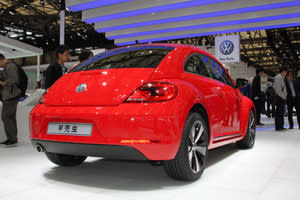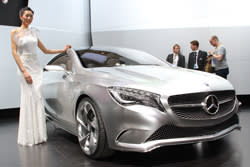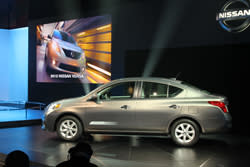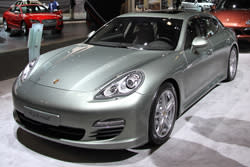Best of the 2011 New York & Shanghai Auto Shows
The latest in highly fuel efficient — and in some cases high-powered — production cars.
The automobile industry’s stars aligned to make this year’s New York and Shanghai auto shows open on the same week, and because of this overlap, several new models were introduced almost simultaneously on separate continents.
Shanghai showcased more concept cars, while New York focused mainly on production models. But with oil prices off the charts (the average price for unleaded gasoline in the U.S. is nearing $4 per gallon) the common theme was fuel economy -- and not just for small economy cars, as even Porsche premiered a new hybrid model. There were also five major compact car debuts, and several major updates to various compact and subcompact models.
Of course, a few manufacturers (Chrysler, Jeep, and Shelby, to name them) didn’t get the efficiency memo and debuted hot rods and over-the-top muscle cars, just to keep us guessing (and scratching our heads). But those were the exceptions to the rule.
Volkswagen sold 23 million original Beetles, and 6 million in the United States alone. As a testament to the global market, the 2012 Volkswagen Beetle was unveiled nearly simultaneously in New York and Shanghai, with a third appearance in Berlin.
Sales of the New Beetle had stalled in recent years, so VW went back to the drawing board for only the third redesign in the car's 73-year history. Klaus Bischoff, head of design for the Volkswagen brand, sums up the new design in one word: "Masculine."
Indeed, while the last Beetle skewed feminine with dash-mounted bud vases and a three-circle form, the new version aims to strike a different chord.
“We started from scratch,” Bischoff said. “We wanted to give it a whole new character, to make a dynamic, sportier, more masculine car.” The car eschews the three-circle simplicity of the outgoing model and its high roof. Instead, Bischoff looked back to the original Beetle, as designed by Ferdinand Porsche. “We had an original one in the studio,” he said. The hood of the new car is longer, the windshield moves rearward and rests at a lower angle, while overall width and length have increased. As a result, the car sports a hunkered-down appearance while remaining instantly recognizable as a Beetle.
The newfound machismo may come down to the 19-inch, 10-spoke wheels. “Big wheels are masculine,” Bischoff said. The interior also brings in exterior color in a similar fashion to the new Fiat 500 and Mini Cooper. The top-end TSI model is available with an XDS differential and traction control system. Luca De Meo, VW’s director of marketing says “it makes it sporty, like the Herbie in the movie." The standard engine will be a 2.5-liter, 170-hp four-cylinder and a 2-liter, 140-hp turbodiesel four-cylinder that gets between 29 and 40 mpg.
Carroll Shelby has not been satisfied in the horsepower department for all of his 88 years. Thus begat the latest beast to wear the Shelby name, the 2012 Shelby GT500 Super Snake unveiled at the New York Auto Show.
The Super Snake package includes a six-speed transmission with short-throw shifter, a Ford Racing handling package with adjustable shocks, special springs, anti-roll bars, a front strut tower brace, forged
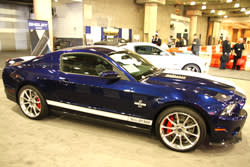
Shelby/Baer brakes with six-piston calipers, a 3.73:1 rear axle ratio, and a fiberglass hood like the 1967 GT500.
Shelby's been down the Super Snake road before, but this latest iteration is the most powerful. The standard package develops 550 hp from the supercharged 5.4-liter V8. The next stage brings that up to 750 hp. The final stage uses a supercharger to churn out an incredible 800 horsepower.
The base Super Snake package costs $34,245 on top of the $48,645 Ford Mustang Shelby GT500, for a total of $82,890.
Due to the tremendous costs, which can easily exceed $5 million per car, most automobile manufacturers build only one copy of any given concept car. Mercedes-Benz doubled down with its latest effort, the Mercedes-Benz Concept A-Class concept car, which premiered in both Shanghai and New York.
The A-Class will spawn four compact-platform Mercedes models over the next few years, says Dr. Joachim Schmidt, Mercedes-Benz's chief sales and marketing executive.
Mercedes says the car's power will come from a 2.0-liter, 210-hp four-cylinder engine with direct fuel injection via a dual-clutch transmission. Electric, hybrid, and high-performance AMG variations are planned.
“
Mercedes wants all the emotion attached to sports cars like SLS and SLK transferred to this small car segment," says Thomas Engl, chief engineer on the A-Class project. "This will attract younger customers we don’t have today in the [subcompact and compact] segments.”
The concept showcases Mercedes designers' love for short side glass, which is attractive, if impractical from a visibility standpoint.
Starting at $10,990, the Versa sedan is the least expensive car in America. On the heels of the Leaf electric vehicle, Nissan has given the 2012 Nissan Versa improved economy, lower emissions, and a surprising amount of interior room (Nissan claims more legroom than in the Lexus LS460, the BMW 5-Series and the Mercedes-Benz E-Class). A hatchback model will follow shortly after the summer launch of the sedan.
Nissan built the new Versa on a new global front-wheel-drive platform which, while similar in size to the one it replaces, weighs 150 pounds less. That means better efficiency and less power required to achieve the same performance.
“High gas prices have indeed shifted our focus and development away from trucks,” Carlos Tavares, Nissan's chairman of the Americas, said. “Oil prices may go even higher, so we plan [ahead] with products like the Versa,” Tavares said. The new Versa achieves better fuel economy than the outgoing model by 5 mpg.
The base Versa is equipped with standard air conditioning, stability control, antilock brakes with electronic brake-force distribution, and electronic power steering. Bluetooth, touch-screen navigation, satellite radio, and an iPod/USB interface are also available.
The new Versa’s 1.6-liter four-cylinder engine develops 109 hp, achieving 30 city mpg and 37 highway mpg (or 33 combined mpg, which Nissan says is a better representation of real-world results) with the continuously-variable automatic transmission. The five-speed manual returns an estimated 27/36 mpg city/highway. Nissan has deleted the previous 1.8-liter engine version of the Versa with this redesign.
All 2012 Nissan Versas will be offered in three trim levels; the S will be available with either a five-speed manual or CVT, while the SV and SL will be CVT-equipped only.
Porsche continues to expand its model range. Having shown the hybrid 918 supercar a year ago and currently offering the Cayenne Hybrid SUV, the company's second production hybrid is the Porsche Panamera Hybrid S.
“The feedback on our hybrid technology has been surprisingly positive,” said Detlef von Platen, Porsche Cars North America's CEO. “Customers understand that the performance they expect is there while being more efficient. Hybrid is a technology we’ve embraced because it's a strong alternative to improve performance and comply with more stringent upcoming fuel economy regulations.”
This combination of a supercharged, direct-injected 3.0-liter V-6 with an electric motor is also used in the Cayenne and Volkswagen Touareg Hybrid. Boosted by a 47-hp electric motor, 380 hp drives the rear wheels through an eight-speed automatic transmission.
Porsche claims the car can reach 60 mph in 5.7 seconds, which is not exactly slow, but not exactly fast for an “S” model Porsche. Top speed is 168 mph. The Panamera can accelerate up to 50 mph on electricity alone, although the range in this mode is just 1.3 miles. The car has not been EPA certified, so fuel economy figures are not yet available.
“You can disengage the engine from the transmission completely at speeds up to 103 mph,” von Platen said. The result is a drastic decrease in mechanical drag, so that maintaining high speeds requires less power and therefore less fuel. “In the end, you get the power and torque of the V8 Panamera S with the economy of a six-cylinder.”
The Panamera Hybrid enters the market while other luxury hybrid sedans have already launched, like the Mercedes-Benz S400 Hybrid with 295 hp, the BMW ActiveHybrid 750i/Li with 455 hp and the Lexus LS600hL with 438 hp. Though Porsche’s approach using a six-cylinder engine is similar to that of Mercedes, the Porsche can be propelled solely on electric power. However, with the goal being heightened efficiency, there is an unavoidable wrinkle. Diesel versions of each sedan (in the European market, not the U.S) return better fuel economy than the hybrid.
“We did consider using a diesel engine in the U.S. when we introduced the diesel in Europe some time ago, but the tax advantages for diesels are much more favorable in Europe,” says von Platen. “Also, the U.S. market was not ready in terms of perception. Today, those perceptions are much different. Diesel is much better thought of as a high-tech product, it is considered clean, and we are strongly considering it in the U.S., but we have not made a decision yet.”
“From another perspective, social acceptability is important to us. In a moment when the economy is bad, unemployment is high, and the mood in the environment for luxury products might not be as favorable as it might have been before, we strive to be mindful of that,” von Platen says. “We’re keen to keep the brand exclusive but also socially responsible. Clean, innovative technology and alternative propulsion development is one way an engineering-focused company like Porsche can express itself.”
For now, the Panamera S hybrid holds the green & efficient playing card in the Porsche deck and will open the bidding at $95,975, some $5,000 more dear than the Panamera S. It will hit showrooms this summer.
Hyundai is focused on fuel economy, but not necessarily with the aid of hybrid technology. Pure electric and other alternative fuels make cars like the Chevy Volt and Nissan Leaf “somewhat questionable as a mass-market solution,” according to John Krafcik, Hyundai's president and CEO. “Continued development of the conventional engine is the key to providing the biggest benefit to the customer.”

 Yahoo Autos
Yahoo Autos 
